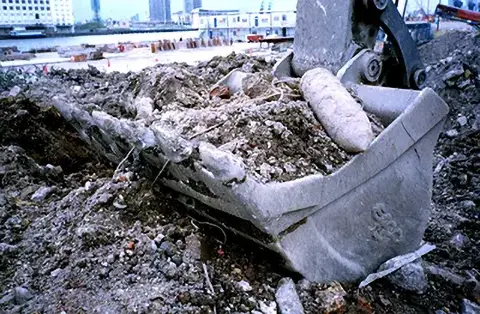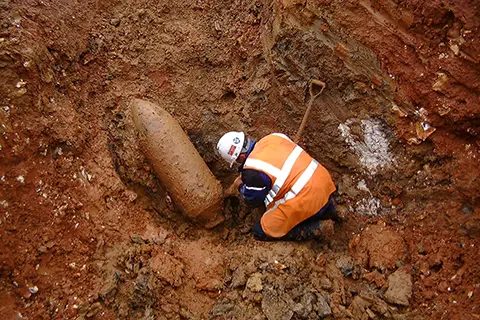Why Glasgow is contaminated with unexploded ordnance?
Igne's research team explain Glasgow's historic significance and why it's contaminated with unexploded ordnance.
Why Glasgow is contaminated with unexploded ordnance?
At the beginning of the 20th century, some 20% of the world’s ships were manufactured by companies situated on the River Clyde in Glasgow.
The area boasted a network of supportive industries and raw materials. For example, nearby Ravenscraig Steel Works provided necessary steel for ship building. In addition extensive coal mining in the area - there were 560 mines at its peak - provided a consistent power supply.
This meant the region had essential elements to help it grow and by WWII Glasgow was thriving. It was home to:
- major shipyards,
- marine engineering businesses,
- iron works,
- power stations,
- Admiralty fuel storage tanks,
- and other heavy industry.
The vulnerability of Glasgow & Clydebank
As an epicentre for ship building, the Glasgow area was particularly vulnerable to German bombing.
The Clyde had become Britain’s main entry point for allied merchant shipping, and its largest berth was used by warships. Despite its distance from mainland Europe, the River Clyde was vulnerable to attacks from long range bombers stationed in Nazi-occupied Norway.
Bombing commenced over the Glasgow region on the 19th July 1940. The city was bombed on 11 occasions up to the 23rd March 1943. Regular air-raid warnings began in Dunbartonshire in June 1940 but there was no significant attack until the night of the 13th March 1941...
The bombing of Glasgow & Clydebank
236 aircrafts dropped 272 tonnes of high explosive BombenSchaltKasten and 59,400 incendiary devices.
The weather conditions were favourable so all crews had a clear view of their targets as they launched the attack. The primary targets of this raid were the docks, shipyards, and industrial facilities in Glasgow.
The attack achieved its objective. Thousands of incendiary bombs were dropped, starting marker fires to assist the further waves of bombing. Clydebank suffered significant losses, with the official death toll being estimated at a minimum of 528 casualties.
Singer’s timber yards, Yorker Distillery and Old Kilpatrick’s oil depot were destroyed by fires as a result of the arrack. Many of the industrial targets in the region were either directly struck by high explosive bombs or sustained severe blast or fire damage as a result of incendiary bomb showers.
Key historic facts:
- Clydebank's housing faced severe destruction. Only seven houses managed to escape any damage.
- Clydebank received a density of bombing of roughly 171 bombs per 1,000 acres. However, due to wartime restrictions, the destruction of Clydebank went almost completely unreported so it could have surpassed this.
- At the Admiralty oil storage depot at Dalnottar, 11 large tanks were destroyed and others severely damaged. Millions of gallons of fuel were lost, and the resulting fires burned for two weeks. When the site was finally cleared, 96 bomb craters were counted.
The risk today
The unexploded ordnance (UXO) risk today comes from buried unexploded air-dropped bombs or anti-aircraft projectiles that failed to detonate.
It is commonly accepted that the failure rate of these munitions was approximately 10% and, depending on their shape, weight, velocity and ground conditions, many penetrated the ground and came to rest at depth.
Although efforts were made during and after the war to locate all UXO, the explosive remnants of war continue to impact societal development today.
This is shown by the regular, on-going discoveries of UXO during construction-related intrusive ground works across the UK.
A sample of recent finds:
- June 2019 - Discovery of an unexploded bomb on a construction site in Glasgow
- July 2020 - Ground shook as bomb squad called to hill behind Largs
- November 2020 - Magnet fishers pulled FOUR unexploded bombs from a river in one day.
- December 2020 -WW2 mine found in Firth of Clyde had 350kg of explosives
Risk mitigation for the construction sector
UXO presents a significant risk to anyone conducting intrusive works, such as those in the construction sector.
Such risks can be addressed if a client has a better understanding of their site-specific risk. Appropriate risk mitigation measures can then be taken where necessary.
The first step of the process is having a desktop study done to understand whether a particular project is at low, medium or high risk of encountering UXO.
As Igne we have over 30 years’ experience in explosive threat mitigation. We are ideally placed to support clients with desktop risk assessments, and to guide their mitigation strategy.
Other articles of interest

Why is UXO still found in Rotherwas, Hereford?
Yesterday, a hand grenade was found in Rotherwas, Hereford. Why is unexploded ordnance (UXO) still found in Rotherwas, Hereford, over 70 years since WWII ended? Learn about Rotherwas' munitions factory, Luftwaffe bombings, and why UXO risk assessments are important for intrusive ground works.

What’s the value of UXO risk mitigation services?
What value do unexploded ordnance (UXO) risk mitigation services bring? What's the potential impact of UXO and who does it affect? Get all the answers to your frequently asked questions here.


